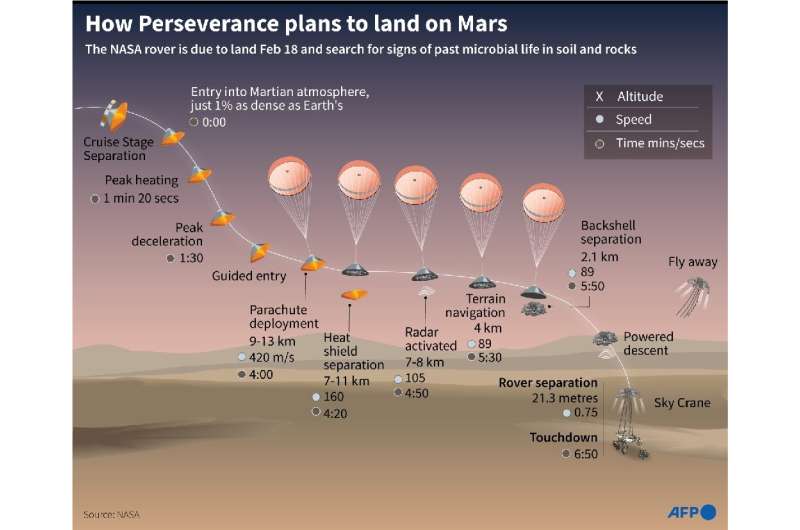Atmospheric entry
Ten minutes before entering the Martian atmosphere, the spacecraft sheds its cruise stage that supplied the fuel tanks, radios and solar panels on the voyage.
It's left with just a protective aeroshell, carrying the rover and descent stage, and it fires thrusters to make sure its heat shield is forward facing.
At about 80 miles (130 kilometers) altitude, it careens into the atmosphere and things start to get hot: peak heating occurs about 80 seconds in when the heat shield surface reaches 2,370 degrees Fahrenheit (about 1,300 degrees Celsius).
Perseverance is tucked away safely in the aeroshell, only experiencing room temperature.
The craft might need to fire thrusters to stay on course as it hits air pockets.
Parachute deployment
Once the spacecraft has slowed down to less than 1,000 miles (1,600 kilometers) an hour, it's time to deploy the 70.5 feet (21.5 meters) wide supersonic parachute at an altitude of seven miles (11 kilometers).
Perseverance is deploying a new technology called Range Trigger that decides the precise moment to deploy, based on the craft's position relative to the landing site.
Asked to name the single most critical event, NASA's EDL lead Allen Chen said: "Obviously there's a lot of concentrated risk in supersonic parachute opening."
To try out its new design, NASA had to carry out extensive supersonic parachute testing from high altitudes here on Earth, a field of research that had been dormant since the 1970s.
Heat shield separation
Next, the spacecraft jettisons its heat shield, around 20 seconds after the parachute has been deployed. The rover is exposed to the atmosphere for the first time, and uses a landing radar to bounce signals off the surface and calculate its precise altitude.
The mission will also see another technology deployed for the first time: the "Terrain Relative Navigation" (TRN) system that uses a special camera to identify surface features and compare them to an onboard map where engineers pre-programmed the safest landing sites.
"That gives our vehicle eyes, and the ability to really see where she's going and figure out where she is," said Chen.
Powered descent
In the thin atmosphere of Mars, the parachute will only get the vehicle down to 200 miles (300 kilometers) per hour—so Perseverance has to cut the chute loose, dispense with its back shell, and use rocket thrusters to ease itself down.
It does this using an eight-engined jetpack that's installed directly above the rover and fires up at around 6,900 feet (2100 meters) above the surface.
The vehicle has to tilt right away in order to avoid the falling parachute and back shell, then uses its sophisticated systems to continue its descent.
Skycrane
With 12 seconds to go, at a height of 66 feet (20 meters), the rocket-powered descent stage lowers the rover down to the ground using long cables in a maneuver called "skycrane."
The rover locks its legs and wheels into a landing position and touches the ground at a little less than two miles (1.2 kilometers) an hour, as the descent stage flies off and makes its own controlled landing.
Perseverance is now set for its mission as Earth's fifth rover on Mars.
© 2021 AFP



